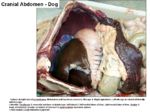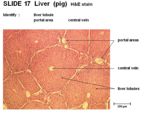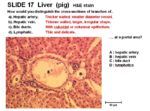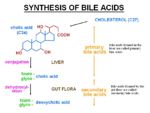Difference between revisions of "Liver - Anatomy & Physiology"
| Line 113: | Line 113: | ||
**Glucocortocoids | **Glucocortocoids | ||
**Catecholamines | **Catecholamines | ||
| − | **Synthesises other important hormones (see [[Endocrine System - Liver - Anatomy & Physiology|Endocrine System]] | + | **Synthesises other important hormones (see [[Endocrine System - Liver - Anatomy & Physiology|Endocrine System]]) |
*Immunoregulation | *Immunoregulation | ||
Revision as of 09:03, 23 July 2008
Introduction
The liver (hepar) is an extremely important organ in the body of mammals and vertebrates as it provides functions essential for life. It is the largest internal organ and has numerous functions including production of bile and protein, fat and carbohydrate metabolism. During foetal development, the liver has an important haemopoetic function, producing red and white blood cells from tissue between the hepatic cells and vessel walls.
The size of the liver varies due to its role in metabolism. In carnivores the liver weighs about 3-5% of body weight, in omnivores 2-3% and in herbivores 1.5%. the liver is much heavier in young animals than older animals as it atropies with age.
The liver is derived from an outpocketing of endoderm epithelium on the ventral duodenum from the caudal part of the foregut. The connection to the gut narrows to become the bile duct. The parenchymal tissue of the liver is formed from proliferating epithelial cords or strands which integrate with the blood sinuses of the umbilical and vitelline veins. The mesoderm of the septum transversum forms the venous sinosoids and connective tissue of the liver.
Structure
- Cranial part of the abdomen
- Immediately caudal to the diaphragm
- Cranial to the stomach and intestines
- Generally the bulk of the liver on the right of the midline
- Divided into lobes by fissures
- Cranially the liver is convex, called the diaphragmatic surface
- Caudally the liver is concave, called the visceral surface
- Caudate lobe has a renal impression from the right kidney
- Gastric impression occupies the whole of the left half of the visceral face
- Duodenal impression at the junction of the right and quadrate lobes continuing onto the right lateral and caudate lobes
- Passages or notches on the median plane allow the caudal vena cava and oesophagus to pass by
- The gall bladder is located between the right medial and quadrate lobes
- Reticular fibres (collagen type III, proteoglycans and glycoproteins) support the hepatocytes and walls of the sinusoids
- Interlobular spaces support bile ducts and blood vessels
- Lesser omentum (often fat filled) on the visceral surface between the left lateral lobe, heptic porta and lesser curvature of the stomach
- Oesophageal notch where oesophagus passes over the liver
Divisions of the Liver
- Lobes
- Lobules
- Hepatocytes and sinusoids
Lobes of the Liver
- Left lateral
- Left medial
- Right lateral
- Right medial
- Quadrate
- Caudate
- Papillary
Ligaments
- Coronary ligament
- Attaches the liver (from the diaphragmatic surface) to the diaphragm
- Irregular fold of peritoneum
- Surounds the triangular base of the diaphragmatic surface
- Continuous with outer most layer of the caudal vena cava
- Falciform ligament
- Ventral to the coronary ligament
- Fat filled embryological remnant of the fetal blood vessels from the placenta
- Causes problems for surgical entry into the abdomen
- Located cranial to the umbilicus
- Vestige of the umbilical vein
- Triangular ligament
- Right and left sides of the coronary ligament
Function
- Production of bile
- Nearly all the blood circulated around the adbomen flows back through the portal vein to the liver where it comes in contact with the liver cells, ensuring the products of digestion are presented to the hepatic cells before entering the general circulation.
- Carbohydrate metabolism
- Glycogenesis
- Glyconeolysis
- Gluconeogenesis
- Breakdown of insulin and other hormones
- Protein metabolism
- Produces soluble mediators of the clotting cascade
- Albumin
- Hormone transporting globulins
- Lipid metabolism
- Lipogenesis
- Synthesis of cholesterol
- Hormonal control
- Insulin and glucagon
- Glucocortocoids
- Catecholamines
- Synthesises other important hormones (see Endocrine System)
- Immunoregulation
- Kupfer cells
- Complement synthesis and metabolism
- Storage
- Water soluble vitamins
- fat soluble vitamins
- Iron
- Triglyceride
- Glycogen
- Breaks down haemoglobin
- Breaks down toxic substances through drug metabolism
- Converts ammonia to urea
- Management of endogenous waste, e.g haem (Hb, cytochromes, Mb) and ammonia (amino acids)
Vasculature
- Dual blood supply
- 70-80% hepatic portal vein (nutrient rich)
- 20-30% hepatic artery (oxygen rich)
- Large blood supply (nearly a 1/3 of cardiac output passes through the liver)
- Hepatic artery
- Branch of the caeliac artery
- Portal vein
- Formed by tributaries draining the spleen, pancreas and digestive tract
- Intrahepatic arteries combine with portal vein branches to supply the connective tissue and hepatic sinusoids of the liver
- Blood flows from the portal areas into the central vein
- Central vein lined by simple squamous epithelium
- The bile duct, blood vessels (including the important hepatic vein) and nerves enter and leave the liver at the hepatic porta
- Blood from the central vein open into the caudal vena cava
- Liver circulation controlled by interarterial, intervenous and arteriovenous, by sphincter mechanisms allowing carefull reglulation
Innervation
- Sympathetic nerves from periarterial plexuses
- Parasympathetic nerves from vagal trunk
Lymphatics
- Efferent vessels pass to hepatic nodes around the hepatic porta
- The lymph drains into the visceral cysterna chyli
- Some lymph travels to the accessory hepatic and caudal mediastinal lymph nodes on the caudal vena cava
Histology
- Connective tissue capsule around each lobule
- Thin mesothelium covers connective tissue layer
- The larger liver cells are called lobules
- Each lobule contains an opening for the central vein and contains portal areas
- Lobules composed of liver cords called hepatocytes
- Sinusoids present between hepatocytes containing red blood cells
- Portal area present in lobules
- Hepatic artery- thick walls, small diameter
- Hepatic vein- thin walls, large and irregular shape
- Bile ducts- cuboidal or columnar epithelium
- Lymphatics- small and delicate
- Hepatocytes are the smaller liver cells in the lobules
- Contain glycogen granules
- Stain pink as are eosinophilic
- Spherical nucleus
- Forms cords called branching plates (lamellae)
- Upper and lower margins are tight junctions
- 3 functioning surfaces
- Adjacent to sinusoid contains microvilli
- Between adjacent cells are smooth
- Adjacent cells have short microvilli, membranes diverge, explanded intracellular spaces and bile canaliculi
- Kupfer macrophages present near the lining of the sinusoids
Hepatic Duct Systems
- Canaliculi within lobules
- Canaliculi opein into larger ductules then into a few large hapatic ducts
- Before and shortly after leaving the hepatic porta the ducts combine into a single trunk which runs to the duodenum
- The cystic duct runs from common trunk to the gall bladder transporting bile from the liver to the gall bladder
- Distal to the cystic duct is the bile duct (ductus choledochus) which transports bile from the gall bladder into the duodenum
- No valves so bile may flow in either direction
Bile Acids
- Composed of cholesterol, bile acids and steroids
- Main bile acid is cholic acid (C24)
- Conjugated to taurine or glycine in the liver to reduce pKa so they exist in an ionised form as bile salts
- Bile salts conjugate with cholesterol and phospholipids and are then secreted into the bile
- 95% are recycled in enterohepatic circulation
- Emulsify fats
- Helps absorb fat soluble vitamins
- In aqueous solution form micelles which are amphiphilic and can transport free fatty acids across the brush border
Species Differences
Canine & Feline
- Both left and right lobes subdivided
- Complete obstruction of the hepatic artery is fatal
- Almost entirely intra-thoracic
- Enlarged caudate process contacts right kidney
Equine
- Contained entirely within the rib cage
- To the right of the midline
- Less lobated
- No gall bladder
- Left lobe subdivided
- No papillary lobe
- In the foal the liver is larger and more symmetrical
- Bile duct opens into the duodenum at the same papillae as the major pancreatic duct
- Bile is constantly secreted
Porcine
- Deep interlobular fissures
- Large amount of interlobular connective tissue
- Mottled appearance
- Deep interlobular fissure divides the lived into 4 lobes- the left, right, medial and lateral
- Small caudate lobe (which does not contact the kidney so no renal impression)
- Mostly on the right of the midline
- No papillary lobe
Ruminants
- Entirely displaced to right of midline
- Fused lobes
Small Ruminants
- Sheep have a deeper umbilical fissure than cows
- Sheep have a smaller caudate lobe than cows
- Sheep have two papillary processes
Avian
- See avian liver






